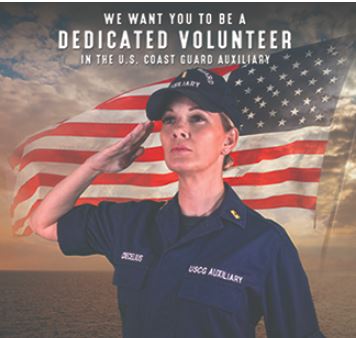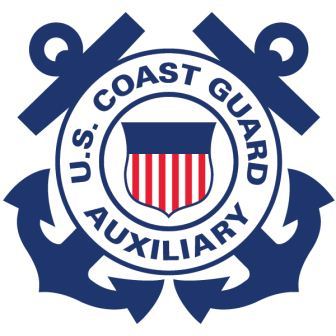Return to Flotilla 11-2's Home Page.
On June 23, 2019, the Coast Guard Auxiliary celebrated 80 years of dedicated service.
Today, the U.S. Coast Guard is comprised of four components: The Active Duty Coast Guard, Reservists, Civilians and Auxiliarists. Together, all four combine to constitute TEAM COAST GUARD.
Below is a history of the Auxiliary
On June 23, 1939, the Congress passed legislation that established the Coast Guard Reserve, the volunteer, uniformed, civilian component of the U.S. Coast Guard. The primary mission was to promote boating safety and to facilitate the operations of the Coast Guard. Groups of boat owners were organized into flotillas and these into divisions within Coast Guard Districts around the country. Members initially conducted safety and security patrols and helped enforce the provisions of the 1940 Federal Boating and Espionage Acts. In February 1941, a military reserve was created and the volunteer Reserve was renamed the U.S. Coast Guard Auxiliary.
Auxiliarists conducting recreational boating checks
Following America’s entry into World War II in December of 1941, recruits flooded into Auxiliary flotillas in a burst of patriotic fever. In June of 1942 legislation allowed Auxiliarists to enroll in the Coast Guard Temporary Reserve on a part-time temporary basis. Throughout the war, some 50,000 Auxiliarists constituted the core of the Temporary Reserve membership. These Temporary Reservists, along with newly enrolled civilians, performed coastal defense and search & rescue duties. They patrolled bridges, factories, docks, and beaches. They fought fires, made arrests, guided naval vessels, and conducted anti-submarine warfare. As their ranks grew, thousands of active duty Coast Guard personnel were freed up for service overseas.
After WWII, the Temporary Reserve was dissolved and the Auxiliarists returned their focus on the growing recreational boating community across the United States in the 1950's, and into the 60's, 70's and 80's. They strengthened their role in educating recreational boaters through safe boating courses, conducted vessel safety checks and assisting with search and rescue functions.
Under legislation passed in 1996, the Auxiliary’s role was expanded to allow members to assist in any Coast Guard mission, except direct law enforcement and military operations, as authorized by the Commandant of the U.S. Coast Guard. Thus, Auxiliarists can be found examining commercial fishing vessels, flying in aircraft, standing radio watch at small boat stations, working in Coast Guard offices, and crewing on active-duty boats, in addition to a variety of other roles.
Today, across the United States the Auxiliary public education programs educate tens of thousands of boaters annually in seamanship, piloting, rules of the road, and weather, among other topics. Specially qualified coxswain and crew members conduct search and rescue missions in their own boats and support other Coast Guard missions. Auxiliary pilots and air observers search for boaters in distress, floating hazards, pollution spills, and ice-locked vessels. Communications watch standers handle distress calls at Coast Guard and Auxiliary radio stations. Vessel Examiners conduct courtesy Vessel Safety Checks on thousands of recreational boats of all sizes from kayaks to 65 foot yachts.
During the decades, the Auxiliary has continued to grow in membership which today totals more than 24,000 members in the United States and its territories. Membership in the Auxiliary is open to persons 17 years of age and older. We have members and units in all 50 states, Puerto Rico, the Virgin Islands, American Samoa and Guam. we are organized into 16 Districts nationwide, comprised of 171 Divisions with approximately 980 Flotillas.
The Coast Guard considers the Auxiliary its primary resource for recreational boating safety outreach and prevention. Each Coast Guard District around the nation has established a senior officer and staff to provide tight liaison and coordination between the active-duty Coast Guard and various Auxiliary units in the District. Collectively, Auxiliarists volunteer over 4.5 million hours per year and complete nearly 500,000 missions with approximately 500 lives saved each year.
To learn more about the various missions we conduct in the Woods Hole Flotilla visit the sections on the left.
Please email our Flotilla Staff Officer - Human Resources
or visit the Auxiliary's National Website
Check out this video about the Auxiliary HERE
-
